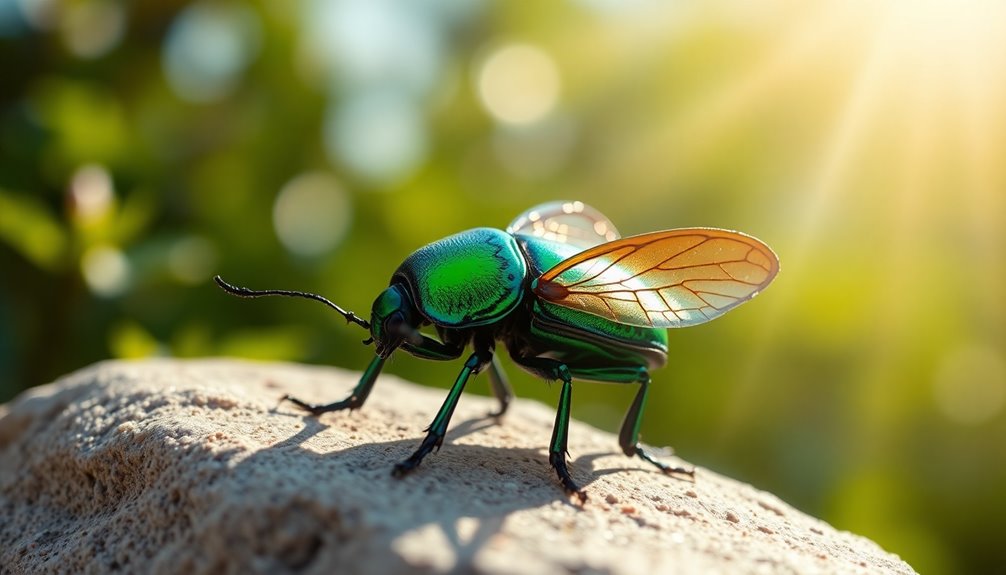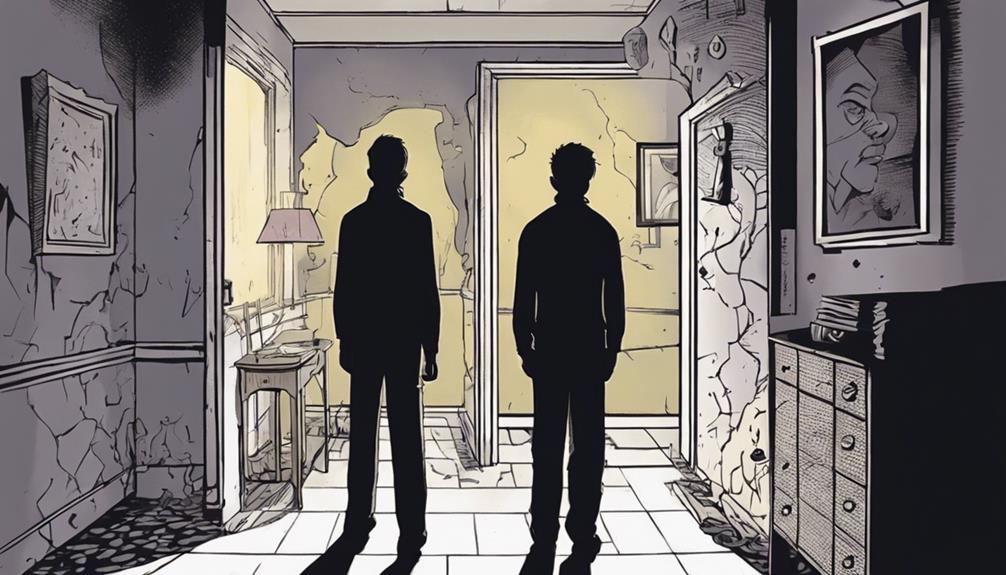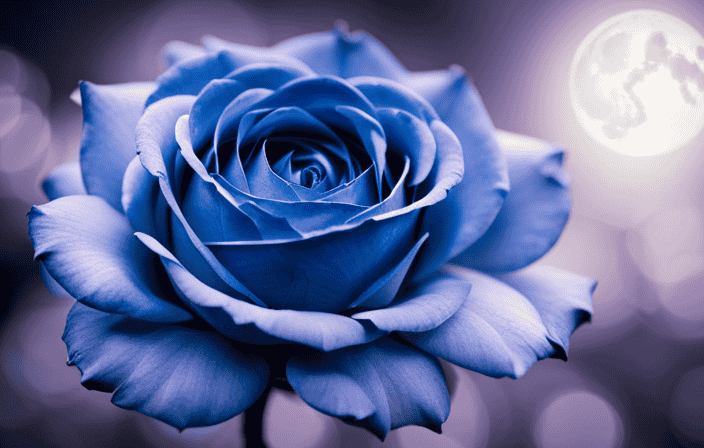The scarab beetle holds a powerful spiritual meaning, inviting you to embrace themes of rebirth and transformation. Revered in ancient Egypt, this symbol connects you to cycles of life and personal growth. As a guardian against misfortune, it offers protection and good fortune, encouraging you to overcome challenges with resilience. The lifecycle of the scarab mirrors your own journey, guiding you through phases of renewal. Wearing scarab jewelry can amplify this energy, inviting luck and positivity into your life. Discover how this ancient symbol can reveal deeper connections and meaning in your personal journey.
Key Takeaways
- The scarab beetle symbolizes rebirth and transformation, reflecting the cycle of life and personal growth through its lifecycle stages.
- Associated with the sun god Khepri, scarabs represent daily creation and the cyclical nature of life, enhancing spiritual energy.
- Heart scarabs serve as powerful protectors against evil, ensuring safe passage for souls in the afterlife, emphasizing spiritual guardianship.
- Scarabs function as amulets of luck, inviting positive energies and prosperity while warding off negative influences in one's life.
- Inscribed with protective spells, scarabs embody hope and renewal, guiding individuals through challenges and promoting spiritual awakening.
Historical Significance of Scarabs
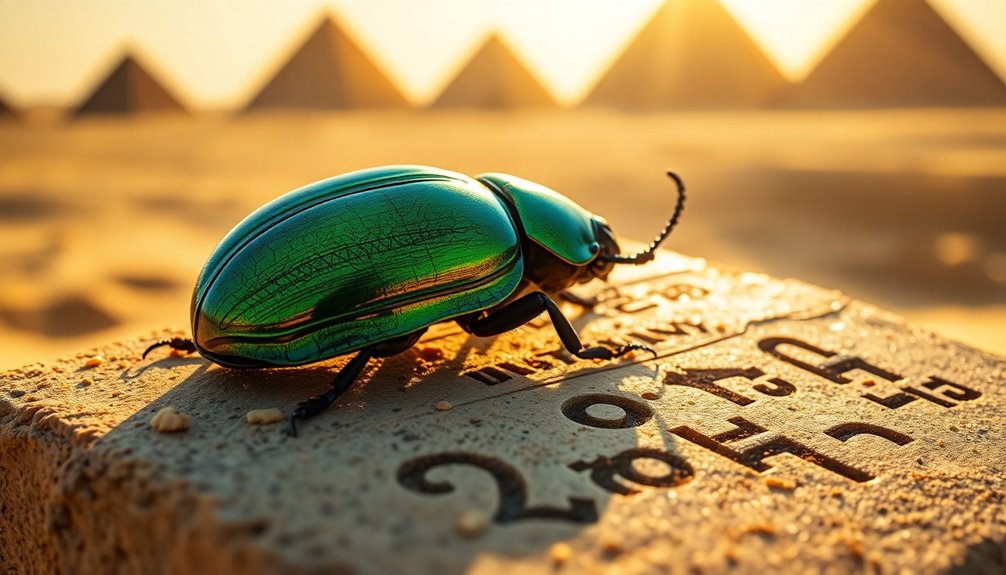
The scarab beetle holds a profound historical significance in ancient Egypt, where it was revered as a powerful symbol of rebirth and regeneration. In ancient Egyptian culture, scarabs were considered the most important amulets, akin to the Christian cross in their cultural weight. They date back to the Old Kingdom, often found in jars with the deceased, illustrating their essential role in funerary practices. These heart scarabs were believed to protect the heart in the afterlife, ensuring a safe passage for the soul.
Throughout various dynastic periods, scarabs were produced extensively, reflecting their enduring importance in both religious and social contexts. The scarab beetle, specifically Scarabaeus sacer, was closely linked to Khepri, the sun god who represented creation and the rising sun. This connection reinforced the scarab's association with the life cycle and rebirth.
Beyond their spiritual significance, scarabs also served practical functions as seals for official documents and jars, blending administrative use with sacred rites. Their multifaceted roles highlight the scarab's integral place in ancient Egyptian society, embodying the essence of life, death, and the promise of renewal.
Symbolism and Spiritual Significance
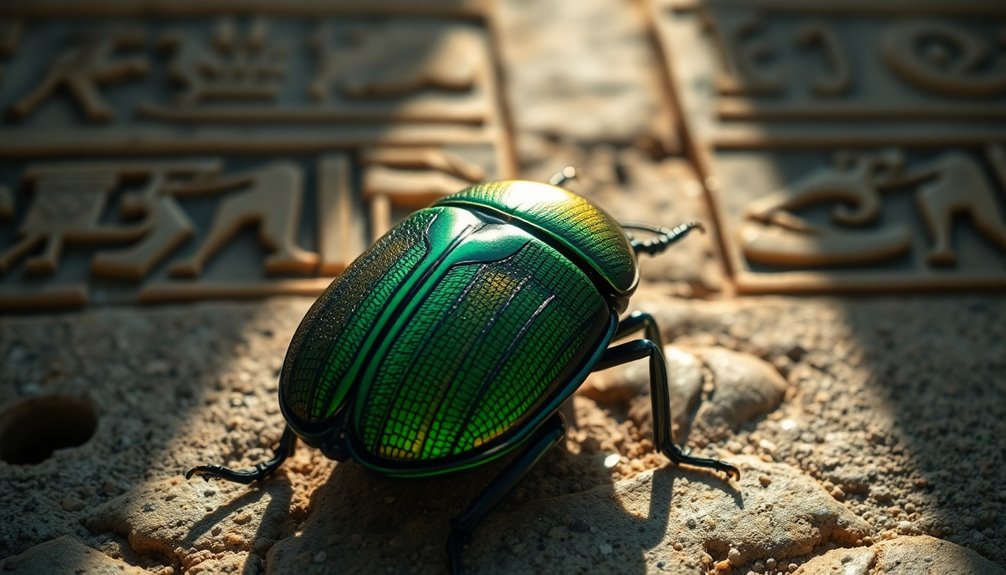
When you think about the scarab beetle, consider its deep symbolism of rebirth and renewal, reflecting your own potential for transformation.
These creatures not only represent personal growth but also serve as powerful protectors, guiding you toward good fortune.
Embracing the scarab's spiritual significance can inspire you to overcome challenges and seek a brighter path.
Rebirth and Renewal
Throughout ancient Egyptian culture, the scarab beetle has long represented profound themes of rebirth and renewal. This connection is especially strong with the sun god Khepri, symbolizing the cycle of creation and the journey of life. The scarab's unique behavior of rolling dung mirrors the sun's path, embodying life's continuous flow from death to resurrection.
Scarab amulets served as powerful tokens, placed in tombs to protect the deceased and facilitate their rebirth in the afterlife. This reinforces the beetle's association with immortality and transformation. The lifecycle of the scarab, evolving from egg to larva to adult, acts as a reminder of your potential for personal renewal.
Here's a visual representation of the scarab's symbolism:
| Symbolism | Significance |
|---|---|
| Rebirth | Life after death |
| Protection | Safeguarding the soul |
| Transformation | Personal growth and renewal |
Protection and Good Fortune
In ancient Egypt, scarab beetles weren't just admired for their physical form; they were seen as potent symbols of protection and good fortune. The ancient Egyptians revered scarabs as powerful amulets, believed to guard against evil and misfortune.
These insects were closely associated with the sun god Khepri, embodying renewal and the promise of new beginnings. This connection reinforced their status as symbols of good fortune.
Heart scarabs, often placed on mummies, were inscribed with spells to guarantee the deceased's safe journey and protection in the afterlife, highlighting their role as guardians. These artifacts emphasized the scarab's significance in religious beliefs, linking the living and the dead through the promise of safe passage.
The behavior of scarabs, particularly their practice of rolling dung, served as a metaphor for the cycle of life and renewal, further enhancing their protective symbolism.
In daily life, scarabs were exchanged as gifts, reinforcing social bonds and conveying wishes of protection and good luck. Consequently, the scarab beetle remains a powerful symbol of protection and good fortune, embodying the ancient wisdom of those who honored its spiritual significance.
Transformation and Growth
Building on the scarab beetle's symbolism of protection and good fortune, its deeper meaning lies in transformation and growth. The scarab reflects an incredible life cycle—from egg to larva, then pupa, and finally to its adult form. This journey embodies personal evolution, encouraging you to embrace your own challenges and pursue transformation.
In ancient beliefs, the scarab was linked to the sun god Khepri, whose daily path across the sky represents rebirth and renewal. Just as Khepri rolls the sun each day, you too can roll away obstacles and shift into new phases of life.
Scarabs served as protective amulets during funerary practices, symbolizing their role in guiding souls through the afterlife, reinforcing the idea of spiritual meaning tied to growth.
Additionally, the scarab's habit of rolling dung into balls signifies self-renewal and the cyclical nature of life. This act provides a powerful metaphor for embracing growth and regeneration.
As you connect with the scarab's energy, remember it's a symbol of good luck and protection, reminding you that each transformation leads to new opportunities and deeper understanding.
Role in Funerary Practices
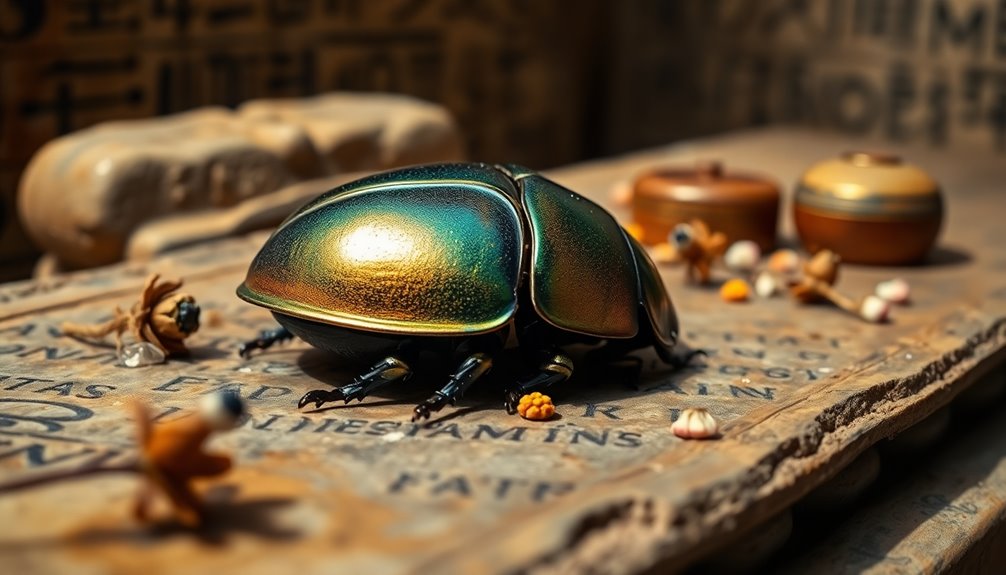
While many symbols played significant roles in ancient Egyptian funerary practices, the scarab beetle stands out as a powerful emblem of protection and rebirth. These scarabs were more than mere decorations; they served essential functions in ensuring the deceased's safe passage to the afterlife.
You'd find heart scarabs, often inscribed with spells from the Book of the Dead, placed directly over the mummies' hearts to protect them during judgment by Osiris.
Here are four key aspects of scarabs in funerary practices:
- Guardians Against Evil: Scarabs acted as spiritual protection, defending against malevolent forces during the soul's journey.
- Symbol of Rebirth: The scarab's connection to regeneration mirrored the ancient Egyptians' beliefs in the cycle of life and death.
- Heart's Importance: The heart's role in the afterlife was emphasized, as it was essential for acceptance by Osiris.
- Craftsmanship: Scarabs were meticulously crafted from materials like green jasper or gold, reflecting their high religious significance.
Guardian of the Underworld
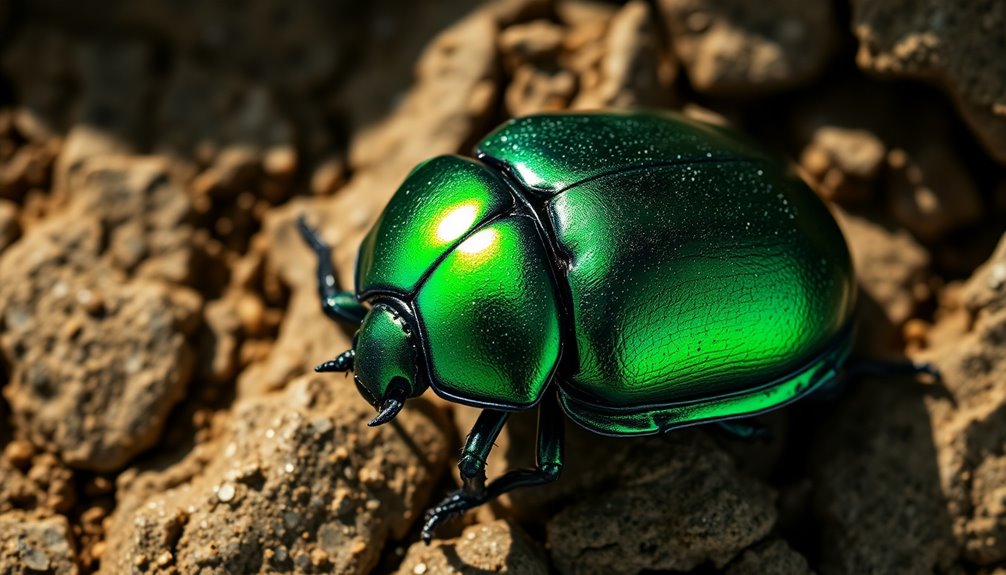
Often regarded as a powerful guardian, the scarab beetle plays an essential role in ancient Egyptian beliefs about the underworld. This small yet mighty creature is seen as a spiritual protector, guiding souls through the challenges of the afterlife. In this domain, you can envision the scarab as a steadfast guardian, ensuring safe passage for the deceased.
The heart scarab, commonly placed on mummies, symbolizes the scarab's vital role in funerary practices. Inscribed with spells and prayers, these artifacts plead for the deceased's heart not to testify against them during judgment. As you reflect on this, consider how the scarab beetle embodies the promise of resurrection, an integral aspect of immortality in Egyptian culture.
Linked closely with the sun god Ra, the scarab's connection to the cycle of life and death illustrates its importance in the journey through the underworld. By serving as a protector, the scarab beetle not only represents the guardianship over the dead but also highlights the profound beliefs surrounding the afterlife in ancient Egypt.
Embracing the scarab's symbolism can inspire you to honor the eternal journey of the soul.
Transformation and Rebirth
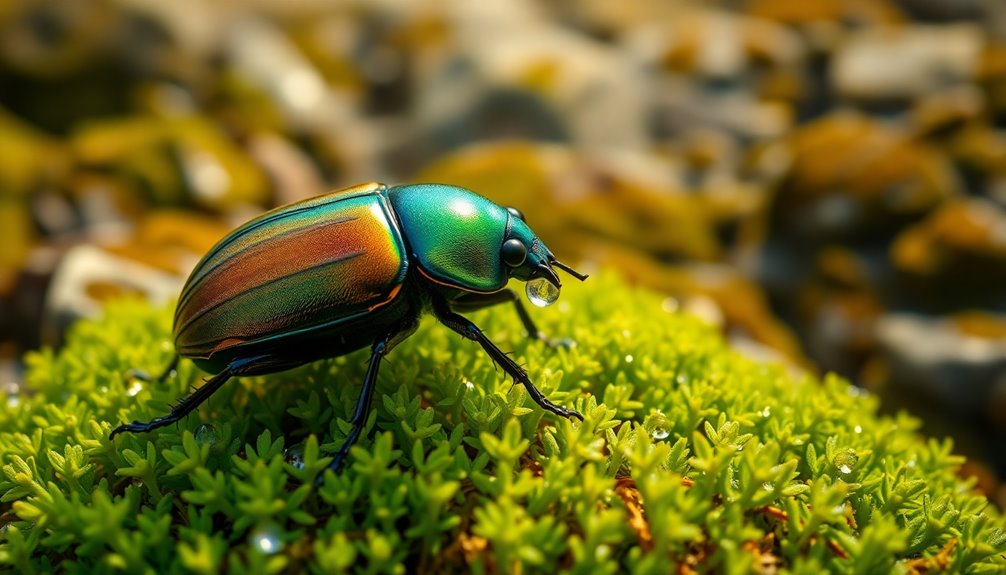
The scarab beetle is a remarkable symbol of transformation and rebirth, deeply rooted in ancient Egyptian beliefs. This incredible creature embodies the cycle of life, death, and renewal, reminding you of your own capacity for change.
As you reflect on the scarab's transformative journey, consider the following aspects:
- Lifecycle Stages: The scarab undergoes stages of egg, larva, pupa, and adult, mirroring your personal growth and ability to overcome challenges.
- Connection to the Sun: Its behavior of rolling dung balls symbolizes the sun's journey across the sky, emphasizing daily creation and rebirth.
- Amulets of Protection: Scarabs were commonly used as amulets in funerary practices, ensuring safe passage to the afterlife and reflecting the belief in regeneration beyond death.
- Spiritual Hope: The scarab serves as a potent emblem of hope, often inscribed with protective spells to facilitate the transformation of the deceased.
Embracing the scarab's teachings can inspire your own spiritual transformation and rebirth.
Allow this ancient symbol to guide you through life's cycles, fostering a deeper connection to your own journey toward renewal.
Amulet of Protection and Luck

Building on the scarab's symbolism of transformation and rebirth, this remarkable beetle also serves as a powerful amulet of protection and luck.
In ancient Egypt, scarabs were revered for their ability to ward off evil and safeguard the wearer throughout life and the afterlife. You might find it fascinating that these amulets were often placed in tombs, ensuring safe passage for the deceased and symbolizing their eternal protection.
The scarab's connection to regeneration and transformation is what makes it a popular symbol for attracting good fortune.
Wearing a scarab as jewelry or carrying it as an artifact can invite positive energies into your life. The heart scarab, in particular, was inscribed with spells designed to prevent the heart from testifying against the deceased, emphasizing its role as a guardian of fortune in the afterlife.
Frequently Asked Questions
What Does the Scarab Beetle Symbolize Spiritually?
The scarab beetle symbolizes rebirth and transformation in spiritual contexts.
It represents the cyclical nature of life and death, reminding you of the continuous journey of the soul. As you embrace change, the scarab encourages you to let go of the past and welcome new beginnings.
Its connection to the sun's journey signifies creation and renewal, urging you to harness your inner strength and seek protection and good fortune in your life.
What Is the Power of the Scarab Beetle?
The power of the scarab beetle lies in its deep connection to transformation and protection.
When you embrace this symbol, you tap into its ability to inspire personal growth and renewal. It reminds you that, like the sun's journey, you can overcome challenges and emerge renewed.
Which God Is the Egyptian Scarab Beetle Associated With?
The Egyptian scarab beetle is primarily associated with the sun god Khepri.
When you think about Khepri, envision the rising sun and the cycle of creation. Khepri symbolizes transformation and renewal, much like the scarab's behavior of rolling dung balls, mirroring the sun's journey across the sky.
This connection highlights the scarab's role in ancient Egyptian mythology, where it represented protection and the power to safeguard souls in their journey to the afterlife.
What God Has a Scarab Beetle Head?
The god with a scarab beetle head is Khepri. You might find Khepri fascinating, as he symbolizes the rising sun and the cycle of rebirth.
In ancient Egyptian mythology, he's depicted as a man with a scarab head, representing transformation and creation. His name connects to the idea of coming into being, reflecting the daily resurrection of the sun.
Khepri embodies the eternal nature of life, a significant aspect of Egyptian beliefs.
Conclusion
As you journey through life, the scarab beetle serves as your faithful guide, a small yet mighty emblem of transformation and rebirth. Like the beetle rolling its ball of dung, you too can shape your challenges into opportunities for growth. Embrace its ancient wisdom, and let it remind you that every ending is merely a stepping stone to a new beginning. With the scarab by your side, you'll reveal the hidden power within and navigate your path with courage and luck.
